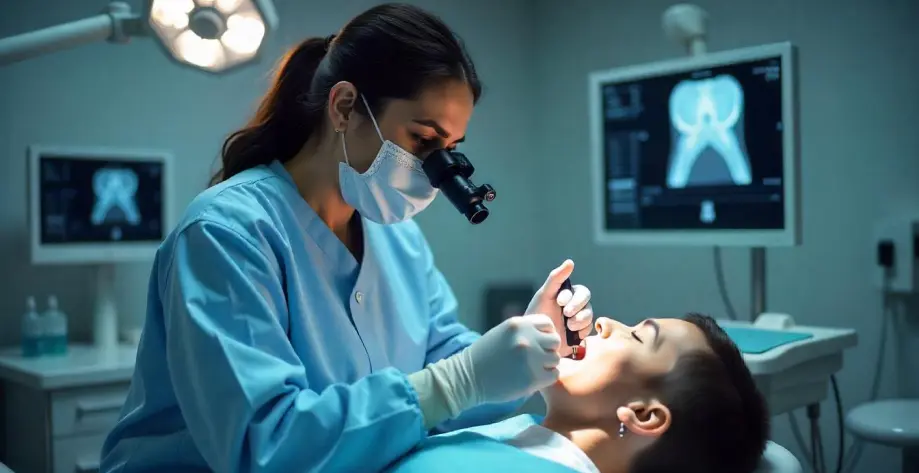Exploring Modern Trends and Innovations in Dental Implant Surgery
Schedule an Appointment
What Are Dental Implants and How Do They Help Damaged Teeth in Patients
Dental implants are a close alternative option for tooth loss caused by damage, trauma, or disease. These implants act like natural roots of your teeth, but they are made of biocompatible materials and need surgery to implant them below the gums or onto the jawbone. In a process called osseointegration, the dental implants connect with your natural bone, so it creates a stable support for other dental procedures. To make your damaged teeth look like natural teeth, implant specialists set prosthetic teeth (e.g., crowns) on the implants. This helps in correcting the overall function of your teeth, allowing you to easily perform functions like chewing, talking, etc.
Modern Trends and Innovations in Dental Implant Surgery
1. Minimally Invasive Dental Implant Techniques
- ✦ Microsurgical Equipment: Implant surgery specialists use microsurgical tools for a less invasive surgery and precise implant procedure to protect the tissue around the damaged teeth.
- ✦ Flapless Dental Implant Surgery: Here, the dental implant is directly placed into the gum tissue without any big cuts (incisions), so the healing time will also be reduced.
- ✦ Quick Implants: For damaged tooth roots, the dental implant is placed immediately in the extraction site of the tooth, so the surgery time is reduced.
2. New and Improved Dental Implant Materials
- ✦ Custom-Milled Abutments (Implant Connectors): CAD/CAM software is used to create custom abutments that match the patient's dental anatomy for better looks and comfort.
- ✦ Zirconia Implants: This material is a better alternative for patients who are sensitive to any kind of metal. This metal-free material is biocompatible and looks like your natural teeth, making it a durable option.
- ✦ Nanocoating: The dental implant can connect more easily with the natural bone with the help of implants that are coated with nanotechnology.
3. Digital 3D Imaging in Dental Implants
- ✦ DSD (Digital Smile Design): Patients with tooth loss can now see how their new smile will look even before the implant surgery using the DSD technology.
- ✦ Cone Beam Computed Tomography (CBCT): This digital imaging technology shows high-resolution 3D jawbone images, which dentists use to check the bone density and anatomy to place the implants accurately.
- ✦ Computer-Guided Dental Implant Method: Implantologists use the digital scans generated by computers to make sure that the dental implants are placed in the correct way without any surgical errors.
4. Bone Regeneration Method
- ✦ Bone Grafting: Materials like bioactive ceramics and synthetic grafts that are used for bone grafts help in increasing the success rate of the implant surgery and reducing the time to heal.
- ✦ 3D-Printed Scaffolds: 3D printing technology is used to create custom scaffolds that can support bone regeneration if there is too much bone loss.
- ✦ PRF and PRP: The patient’s own blood is used to make biological materials like Platelet-Rich Fibrin and Platelet-Rich Plasma, which help in bone regeneration and shorten the healing time.
5. All-on-4, Zygomatic, and All-on-6 Dental Implants
- ✦ All-on-4 Implant Technique: Here, the dental surgeon places 4 implants for better support to your teeth. It not only improves the look of your teeth but also their functionality.
- ✦ Zygomatic Implants: Instead of the jawbone, the dental implants go through the zygoma (cheekbone), which reduces the need for a bone graft.
- ✦ All-on-6 Implant Technique: Six dental implants will go through either in the lower or the upper teeth set to provide support. This helps patients with lower bone density recover faster from the surgery.
6. Robotics and Artificial Intelligence
- ✦ Robot-Assisted Surgery: A robotic system helps the implant specialist place the dental implants accurately during complex surgery cases.
- ✦ AI-Powered Diagnostics: CBCT (Cone Beam Computed Tomography) can be easily analyzed with the help of AI, and further help in planning the treatment process or identifying the best placement sites.
7. Patient-Focused Dental Implant Surgery
- ✦ Sedation Dentistry: For a pain-free dental implant procedure, sedation techniques like nitrous oxide (happy gas) or general anesthesia are used to make the patient feel at ease during the surgery.
- ✦ Improved Aesthetics: New digital imaging, like Digital Smile Design and CBCT, helps in improving the overall dental aesthetics.
- ✦ Same-Day: Patients have the option of same-day dental implants to reduce frequent visits.
8. 3D-Printed Dental Implants
Custom bridges or dental crowns can be quickly printed using 3D printing technology to fix teeth function and improve patient satisfaction.
9. Post-Surgery Monitoring and Maintenance
- ✦ Remote Monitoring: Monitoring the dental implants post-surgery with telemonitoring reduces in-clinic visits.
- ✦ Smart Implants: Smart implants have sensors that detect any early signs of infection, analyze the bite force, and provide insightful data to dentists for easy patient care, even without in-clinic visits.
Conclusion
In conclusion, dental implant surgery has improved with modern trends and innovations like biocompatible materials, minimally invasive techniques, digital imaging, patient-focused techniques, robotics & artificial intelligence, and new bone regeneration methods. At Whitefield Dental Clinic, we use these advanced dental implant surgery methods to replace lost tooth. We not only reduce healing time and surgical errors, but also improve patient care using these advanced dental implant nsinnovations.
